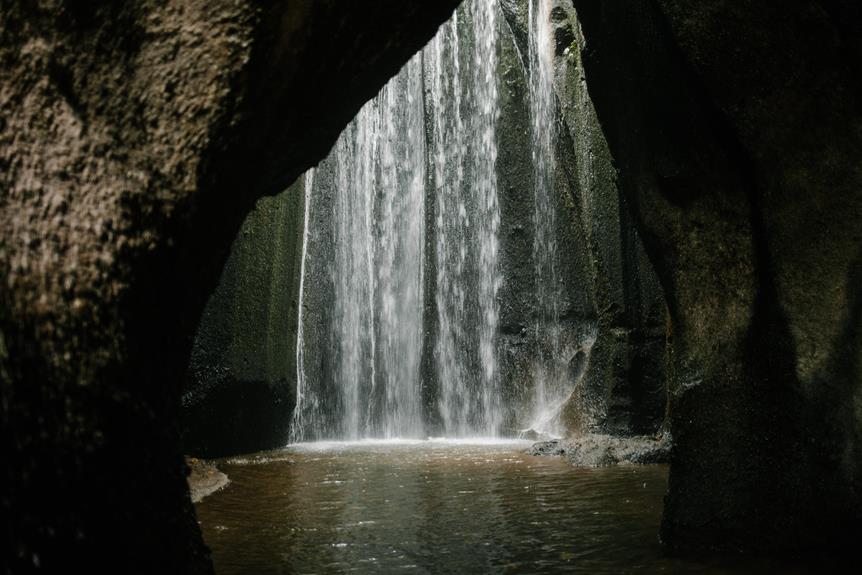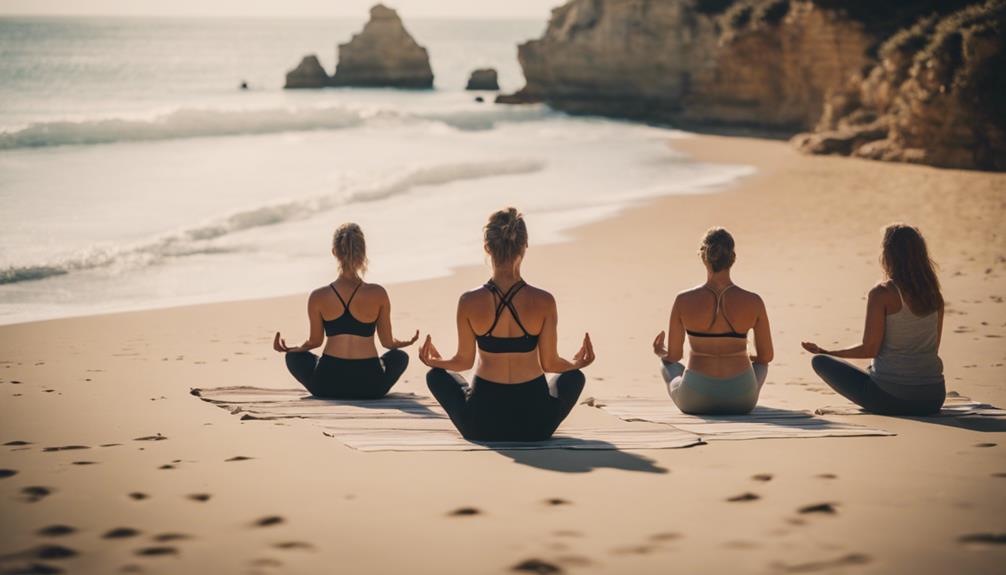Have you ever marveled at the breathtaking beauty of nature's creations?
Well, get ready to be captivated by the incredible journey through Algarve's cliff formations.
This enchanting exploration will take you on a mesmerizing adventure, where you will witness the wonders of erosion, tectonic activity, coastal erosion, geological factors, and the delicate balance between preservation and tourism.
As your guide, I am thrilled to serve you on this remarkable journey, sharing fascinating insights and providing you with an unforgettable experience.
So, whether you choose to embark on a kayak adventure, a boat tour, or a scenic walk along the cliffs, prepare to be awestruck by the natural wonders that await you in Algarve.
Let's embark on this extraordinary expedition together!
Key Takeaways
- Erosion and weathering shape the cliffs along the Algarve coast, creating stunning rock formations and natural arches.
- Tectonic activity has also played a role in shaping the cliffs, adding to their unique beauty.
- The Algarve's cliffs showcase a variety of features, including natural arches, caves, and rock formations, such as those found at Praia da Marinha and Ponta da Piedade.
- Tourism poses a challenge in preserving the natural beauty of the cliffs, and conservation efforts focus on protecting delicate ecosystems and promoting responsible tourism practices.
Erosion and Weathering: The Beginnings of Cliff Formations
One of the key factors in the formation of the stunning cliffs along the Algarve coast is the process of erosion and weathering. These natural wonders, such as the famous Ponta da Piedade, have been shaped over centuries by the relentless forces of nature.
As the waves crash against the coastline, they gradually wear away the limestone cliffs, sculpting them into magnificent rock formations. It's a sight to behold, the result of countless years of erosion and weathering. The cliffs stand tall and proud, their jagged edges and intricate patterns telling a story of the Earth's ever-changing landscape.
Each crevice and groove is a testament to the power of nature. The Algarve's cliff formations are truly a sight to behold, a testament to the beauty and grandeur of our natural world.
Tectonic Activity: Shaping Algarve's Cliff Landscape
Through tectonic activity, the Algarve's cliff landscape has been shaped into a breathtaking natural wonder. The Algarve coast is home to numerous stunning rock formations and cliffs, each with its own unique beauty. From the limestone cliffs surrounding Praia Dona Ana and Praia do Camilo in Lagos, to the extraordinary red and ocher cliffs of Praia da Falésia, the evidence of tectonic activity is evident. The cliffs of Ponta da Piedade boast natural arches and caves, formed through a combination of tectonic activity and erosion. Praia da Marinha showcases stunning rock formations and turquoise waters, while Praia da Albandeira offers visitors a unique beach experience. As I explore these cliffs and rock formations, I am in awe of the power of tectonic activity in shaping the Algarve's natural wonders.
| Cliffs and Rock Formations | Location | Description |
|---|---|---|
| Praia Dona Ana | Lagos | Limestone cliffs surround this beach, creating a picturesque setting. The cliffs are formed through tectonic activity and offer stunning views of the ocean. |
| Praia da Falésia | Algarve coast | These red and ocher cliffs stretch for 7 kilometers, offering breathtaking views of the Atlantic coastline. The cliffs are the result of tectonic activity and erosion, creating a unique and colorful landscape. |
| Ponta da Piedade | Lagos | These cliffs feature natural arches, caves, and rock formations that have been shaped by tectonic activity and erosion. Visitors can explore these formations through boat trips, marveling at the stunning beauty of the landscape. |
| Praia da Marinha | Algarve coast | This beach is known for its stunning rock formations and turquoise waters. The cliffs surrounding Praia da Marinha are a testament to the power of tectonic activity, creating a breathtaking natural wonder. |
Coastal Erosion: The Continuous Transformation of Cliffs
As an avid explorer of the Algarve's cliff landscape, I've witnessed firsthand the ongoing transformation of these natural wonders through coastal erosion. It's truly remarkable how the continuous force of the ocean has shaped the stunning rock formations along the coastline.
One of the most breathtaking spots to observe this transformation is at Ponta da Piedade. With its limestone rocks and golden cliffs, Ponta da Piedade offers a mesmerizing sight of ochre cliffs, rock arches, and hidden caves.
Another must-visit destination is Praia da Dona Ana, one of the most beautiful beaches in Algarve. Its proximity to Ponta da Piedade allows visitors to take a boat tour and explore the cliffs from a different perspective.
Whether walking along the boardwalks or taking a boat tour, a visit to the Ponta da Piedade area is a chance to witness the natural beauty created by coastal erosion and immerse oneself in the captivating history of these stunning cliffs.
Geological Factors: Influence on Cliff Formation in Algarve
The geological factors behind the formation of the cliffs in Algarve have played a pivotal role in shaping their unique and captivating features. The combination of limestone and clay has created a stunning display of rock formations and natural arches along the coastline. At Ponta da Piedade, the cliffs rise up to an impressive 40 meters, showcasing the power of geological processes over time. As I stood on the limestone staircase leading down to the water, I marveled at the impact of erosion, which has formed caves and stacks that dot the coastline.
From Praia de Dona Ana to Nossa Senhora da Piedade, Praia do Camilo to Praia de Albandeira, the cliffs create a picturesque and dramatic landscape that draws visitors in. The Farol da Ponta da Piedade, Meia Praia, Barranco do Martinho, and the famous Benagil Caves are just a few examples of the incredible sights that can be found along the Algarve coast.
As I explored these geological wonders, I couldn't help but appreciate the delicate balance between preservation and tourism in these cliff areas.
[Transition sentence for the subsequent section: 'Human Impact: Balancing Preservation and Tourism in Cliff Areas']
Human Impact: Balancing Preservation and Tourism in Cliff Areas
Tourism poses a delicate challenge in preserving the natural beauty of the Algarve's cliff areas. As visitors flock to the stunning beaches and breathtaking views along the coastline, the impact on these rock formations becomes a concern.
To strike a balance between preservation and tourism, several measures have been implemented:
- Conservation efforts focus on protecting the natural pools and aquatic life that thrive in the cliff areas. Strict guidelines are in place to ensure that visitors don't disturb these delicate ecosystems.
- Responsible tourism practices are encouraged, such as limiting the number of visitors in certain areas and promoting sustainable activities like hiking and birdwatching.
- Education and awareness campaigns aim to inform tourists about the fragility of the cliffs and the importance of preserving them for future generations.
Frequently Asked Questions
Where Are the Rock Formations in Algarve?
The rock formations in the Algarve are truly breathtaking. From the best viewpoints to exploring hidden caves along the cliffs, the geological significance and unique flora and fauna make it a must-visit destination.
How Old Are Algarve Cliffs?
The Algarve cliffs have been shaped over millions of years through a fascinating formation process. The geological timeline, erosion patterns, and coastal erosion have contributed to their unique beauty and stability. The rock layers and sedimentary rocks offer valuable fossil evidence.
What Are the Natural Features of the Algarve?
The natural features of the Algarve are breathtaking landscapes, coastal beauty, unique rock formations, natural arches, hidden caves, and spectacular viewpoints. The erosion patterns have created geological wonders, while the region's flora and fauna add to its natural heritage.
What Type of Rock Is in the Algarve?
The rock in the Algarve is predominantly limestone, a sedimentary rock formed from the accumulation of marine sediments over millions of years. Its composition, formed through geological processes and erosion, gives rise to the stunning coastal landforms and unique characteristics of the region.
Conclusion
As I stand on the edge of Ponta da Piedade, gazing out at the breathtaking cliffs and rock formations, I can't help but wonder: how have these natural wonders withstood the test of time?
The erosive forces of nature and the influence of human activity have shaped this landscape into a true masterpiece. But as we marvel at its beauty, we must also question how we can preserve and protect these cliffs for future generations.
The journey through Algarve's cliff formations is a reminder of the delicate balance between preservation and tourism.



